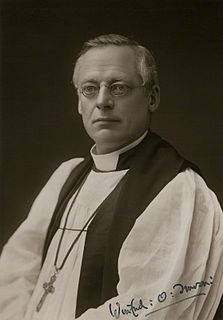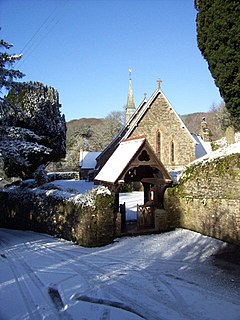Related Research Articles
The Bishop of St Andrews, Dunkeld and Dunblane is the Ordinary of the Scottish Episcopal Diocese of St Andrews, Dunkeld and Dunblane. The see is located at St Ninian's Cathedral in Perth, Scotland.
Crockford's Clerical Directory (Crockford) is the authoritative directory of Anglican clergy and churches in the United Kingdom and Ireland, containing details of English, Irish, Scottish and Irish benefices and churches, and biographies of around 26,000 clergy in those countries as well as the Church of England Diocese in Europe in other countries. It was first issued in 1858 by John Crockford, a London printer and publisher.
Charles Boyd, MA was Archdeacon of Colombo from 1891 until 1901.

Charles John Ridgeway was an English churhman, the Bishop of Chichester from 1908 to 1919.

Winfrid Oldfield BurrowsDD was the Bishop of Truro and later Chichester in the first third of the 20th century.
Charles Thornton Primrose Grierson was an eminent Irish clergyman in the first third of the 20th century. Gaining an MA, then ordained in 1881, he began his career with a curacy at Kells, after which he was Rector of Stradbally and then Seapatrick, County Down. Promotion to be Dean of St Anne’s Cathedral, Belfast followed; after which he was elevated to the Episcopate as the Bishop of Down, Connor and Dromore. Works. He contributed to the monumental "Dictionary of Christ and the Gospels" 1908 edited by Hastings.
The Rt Rev Samuel Morley was Bishop of Tinnevelly at the turn of the nineteenth and twentieth centuries.

John Reginald Harmer was a long-serving Anglican bishop who served in two dioceses.

The Anglican Diocese of St Arnaud was a diocese of the Church of England in Australia, in the Mallee and Wimmera regions of north-west Victoria. It was created in 1926 out of the Diocese of Ballarat and named after the town of St Arnaud. In 1976 it was amalgamated into the Diocese of Bendigo.
The Clerical Guide or Ecclesiastical Directory was the earliest ever specialist directory to cover the clergy of the Church of England. In its initial format it appeared just four times – in 1817, 1822, 1829 and 1836, under the editorial direction of Richard Gilbert.
Richard Henry Malden, BD,, Dean of Wells, was a prominent Anglican churchman, editor, classical and Biblical scholar, and a writer of ghost stories.

The Archdeacon of Raphoe is a senior ecclesiastical officer within the Anglican Diocese of Derry and Raphoe. As such he or she is responsible for the disciplinary supervision of the clergy within the Raphoe part of the Diocese, which is by far the largest.

The Church of St Thomas the Apostle, Killinghall, is an Anglican parish church in Killinghall, North Yorkshire, England. It was designed in 1879 by William Swinden Barber when the parish of Ripley was split to create the additional parish of Killinghall, and a new building was required to accommodate a growing congregation. It was opened in 1880. Among the early vicars posted in this benefice were two canons, Sydney Robert Elliston and Lindsay Shorland-Ball, and the Venerable Robert Collier, an Irish missionary who served in India and Africa.
Charles D’Aguilar Lawrence was Archdeacon of Suffolk from 1901 to 1917.

The Archdeacon of Aghadoe was a senior ecclesiastical officer within the Anglican Diocese of Limerick, Ardfert and Aghadoe from the mid thirteenth century to the early 20th. As such he was responsible for the disciplinary supervision of the clergy within his part of the Diocese of Ardfert ; and then the combined diocese of Limerick, Ardfert and Aghadoe.
(Townley) Blackwood Price(1815-1902) was Archdeacon of Down from 1889 until 1899.
George Finlay was an Irish Anglican priest in the late nineteenth and early twentieth centuries: he was Archdeacon of Clogher from 1886 until 1903.
David Charles Abbott was an Irish Anglican priest in the late nineteenth and early twentieth centuries: he was Archdeacon of Clogher from 1906 until 1917.

St Paul's, Cambridge is a Church of England parish church situated 0.8 miles (1.3 km) to the south east of the city centre of Cambridge, on the corner of St Paul's Road with Hills Road. St Paul's is part of the Cambridge South Deanery in the Anglican Diocese of Ely. The church is a Grade II Listed Building. and has a place in the history of the Gothic Revival due to criticism from the Cambridge Camden Society in the first issue of The Ecclesiologist. The vicar is Michael Beckett.

St Anne's Church is a parish church in the village of Hessenford in Cornwall. It is dedicated to St Anne, the mother of the Virgin Mary. The church is in the Archdeaconry of Bodmin, in the Diocese of Truro. The church is largely the work of J P St Aubyn, and is Grade II listed.
References
- 1 2 3 Archived 2012-04-07 at the Wayback Machine Church Times: two-part article "Shop-talk and mordant wit", by Christopher Currie & Glyn Paflin, describing the background to Crockford's Clerical Directory's first hundred editions, 6–13 December 2007
- ↑ The 1841 first edition of the Clergy List may be downloaded free of charge from the Google eBookstore </